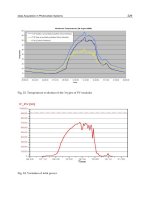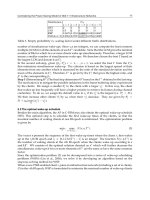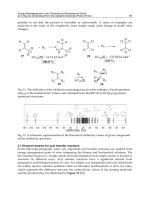Remote and Telerobotics part 16 potx
Bạn đang xem bản rút gọn của tài liệu. Xem và tải ngay bản đầy đủ của tài liệu tại đây (166.04 KB, 3 trang )
RemoteandTelerobotics218
behaviour that is not natural for the user can be learned by the user through accommodation
process, which is more difficult but sometimes the only way of appropriation. Keeping that
in mind, we proposed different control modes. Evaluation results show that natural
behaviours, meaning behaviours easily understandable by the user, lead to better
performances than the others. The same idea has been followed concerning delay treatment.
In that case, feedback information to the remote operator is presented as if the movement of
the robot would be realised without delay. The robot must have autonomy capacities to
make the real movement safe.
We also have developed a simulator of our robot. That offers two advantages particularly
interesting in the context of the assistance to the person in loss of autonomy: time saving
and training in full safety for the person. In addition, it allows a drastic reduction of
logistical costs of training and solves the problem of the low availability of the disabled.
This allows to save time with regard to the training of the operators. Indeed, the beginners
loose less time to achieve the mission in virtual situation than those in real situation.
However, the same number of tests gives an equivalent level to the operators whatever
the situation. A formation with simulation thus seems to be as effective as a formation
with the real robot, while taking less time. The use of the robot by beginners involves
risks. The results of our experiment show that the use of simulation makes it possible to
reach a level of expertise equivalent to that of people trained with the physical robot,
while avoiding these risks. At the time of the training, in simulation as in real situation,
errors can be made, for example the robot or the manipulator can run up against
obstacles. However, the consequences are not the same ones for both situations. These
errors do not have any consequence, from a material point of view, in simulation,
contrary to the real situation for which the same errors can damage the robot. Moreover
one knows that the errors can help with the training, allowing to learn what one should
not do. Simulation thus makes it possible to the users to make virtual errors, teaching
them what it is necessary to avoid making and not to make these errors in real situation
again. In addition, making errors in simulation should harm less the confidence of the
operators in their capacities to control the robot, contrary to the real situation in which an
error has a “cost”. For quadriplegic people who will have perhaps little confidence in
their capacity to control such a system, simulation can enable them to acquire this self-
confidence, and not to lose it if they make errors.
6. References
[AitAider01] O. Ait Aider, P. Hoppenot, E. Colle : "Localisation by camera of a rehabilitation
robot" - ICORR 7
th
Int. Conf. On Rehab Robotics, Evry, France, pp. 168-176, 25-27
avril 2001.
[AitAider02a] Omar Ait-Aider, Philippe Hoppenot, Etienne Colle : "Adaptation of Lowe's
camera pose recovery algorithm to mobile robot self-localisation" - Robotica 2002,
Vol. 20, pp. 385-393, 2002.
[AitAider02b] O. Ait Aider, P. Hoppenot, E. Colle: "A Model to Image Straight Line
Matching Method for Vision-Based Indoor Mobile Robot Self-Location" - In Proc. of
the 2002 IEEE/RSJ international Conference on Itelligent Robots and Systems,
IROS'2002, Lausanne, pp. 460-465, 30 September - 4 October 2002.
[AitAider05] Omar Ait Aider, Philippe Hoppenot and Etienne Colle: "A model-based
method for indoor mobile robot localization using monocular vision and straight-
line correspondences" - Robotics and Autonomous Systems, vol. 52, p. 229-246,
2005
[Ayache86] N. Ayache and O. Faugeras and O. D. Hyper – “A New Approach for the
Recognition and Positioning of Two-Dimensional Objects”. IEEE Transactions on
Pattern Analysis and Machine Intelligence, 8(1), 1986, 44-54.
[Baldwin99] J. Baldwin, A. Basu, and H. Zhang. Panoramic video with predictive windows
for telepresence applications, 1999. International Conference on Robotics and
Automation.
[Bares97] J. Bares, and D. Wettergreen. Lessons from the Development and Deployment of
Dante II, 1997, Field and Service Robotics Conference.
[Benreguieg97] M. Benreguieg, P. Hoppenot, H. Maaref, E. Colle, C. Barret: "Fuzzy
navigation strategy : Application to two distinct autonomous mobile robots" -
Robotica, vol. 15, pp. 609-615, 1997.Obstacle avoidance
[Cobzas05] D. Cobzas, and M. Jagersand. Tracking and Predictive Display for a Remote
Operated Robot using Uncalibrated Video, 2005. ICRA 2005.
[Elson02] J. Elson, L. Girod, and D. Estrin. Fine-grained network time synchronization using
reference broadcasts. ACM SIGOPS Operating Systems Review, 36(1):147-163, 2002.
[Fong01] Fong, T., & Thorpe, C. (2001). Vehicle teleoperation interface. Autonomous Robots,
11, 9-18.
[Friz99] H. Friz. Design of an Augmented Reality User Interface for an Internet based
Telerobot using Multiple Monoscopic Views, 1999. Diploma Thesis.
[Gaillard93] Gaillard, J.P. (1993). Analyse fonctionnelle de la boucle de commande en
télémanipulation. In A. Weill-Fassina, P. Rabardel & D. Dubois (Eds),
Représentations pour l’action. Toulouse : Octares.
[Garcia03] C. E. Garcia, R. Carelli, J. F. Postigo, and C. Soria. Supervisory control for a
telerobotic system: a hybrid control approach. Control engineering practice, 11(7):805-
817, 2003.
[Grasso96] Grasso, R., Glasauer, S., Takei, Y., & Berthoz, A. (1996). The predictive brain :
Anticipatory control of head direction for the steering of locomotion. NeuroReport,
7, 1170-1174.
[Grimson87] W. E. L. Grimson and T. Lozano-Perez – “Localizing Overlapping Parts by
Searching the Interpretation Tree”. IEEE Transactions on Pattern Analysis and
Machine Intelligence, 9(4), 1987, 469-481.
[Grimson90a] W. E. L. Grimson and D. P. Huttenlocher – “On the Sensitivity of the Hough
Transform for Object Recognition”. IEEE Transactions on Pattern Analysis and
Machine Intelligence, 12(3), 1990, 255-274.
[Grimson90b] W. E. L. Grimson – “Object Recognition: The Role of geometric Constraints”.
MIT Press, 1990.
[Henderson01] T. Henderson. Latency and user behaviour on a multiplayer game server,
2001. 3rd International Workshop on Networked Group Communications (NGC).
[Hoppenot96] P. Hoppenot , M. Benreguieg, H. Maaref., E. Colle. and C. Barret: "Control of a
medical aid mobile robot based on a fuzzy navigation" - IEEE Symposium on
Robotics and Cybernetics, Lille, France, pp. 388-393, july 1996.
Anoriginalapproachforabetterremotecontrolofanassistiverobot 219
behaviour that is not natural for the user can be learned by the user through accommodation
process, which is more difficult but sometimes the only way of appropriation. Keeping that
in mind, we proposed different control modes. Evaluation results show that natural
behaviours, meaning behaviours easily understandable by the user, lead to better
performances than the others. The same idea has been followed concerning delay treatment.
In that case, feedback information to the remote operator is presented as if the movement of
the robot would be realised without delay. The robot must have autonomy capacities to
make the real movement safe.
We also have developed a simulator of our robot. That offers two advantages particularly
interesting in the context of the assistance to the person in loss of autonomy: time saving
and training in full safety for the person. In addition, it allows a drastic reduction of
logistical costs of training and solves the problem of the low availability of the disabled.
This allows to save time with regard to the training of the operators. Indeed, the beginners
loose less time to achieve the mission in virtual situation than those in real situation.
However, the same number of tests gives an equivalent level to the operators whatever
the situation. A formation with simulation thus seems to be as effective as a formation
with the real robot, while taking less time. The use of the robot by beginners involves
risks. The results of our experiment show that the use of simulation makes it possible to
reach a level of expertise equivalent to that of people trained with the physical robot,
while avoiding these risks. At the time of the training, in simulation as in real situation,
errors can be made, for example the robot or the manipulator can run up against
obstacles. However, the consequences are not the same ones for both situations. These
errors do not have any consequence, from a material point of view, in simulation,
contrary to the real situation for which the same errors can damage the robot. Moreover
one knows that the errors can help with the training, allowing to learn what one should
not do. Simulation thus makes it possible to the users to make virtual errors, teaching
them what it is necessary to avoid making and not to make these errors in real situation
again. In addition, making errors in simulation should harm less the confidence of the
operators in their capacities to control the robot, contrary to the real situation in which an
error has a “cost”. For quadriplegic people who will have perhaps little confidence in
their capacity to control such a system, simulation can enable them to acquire this self-
confidence, and not to lose it if they make errors.
6. References
[AitAider01] O. Ait Aider, P. Hoppenot, E. Colle : "Localisation by camera of a rehabilitation
robot" - ICORR 7
th
Int. Conf. On Rehab Robotics, Evry, France, pp. 168-176, 25-27
avril 2001.
[AitAider02a] Omar Ait-Aider, Philippe Hoppenot, Etienne Colle : "Adaptation of Lowe's
camera pose recovery algorithm to mobile robot self-localisation" - Robotica 2002,
Vol. 20, pp. 385-393, 2002.
[AitAider02b] O. Ait Aider, P. Hoppenot, E. Colle: "A Model to Image Straight Line
Matching Method for Vision-Based Indoor Mobile Robot Self-Location" - In Proc. of
the 2002 IEEE/RSJ international Conference on Itelligent Robots and Systems,
IROS'2002, Lausanne, pp. 460-465, 30 September - 4 October 2002.
[AitAider05] Omar Ait Aider, Philippe Hoppenot and Etienne Colle: "A model-based
method for indoor mobile robot localization using monocular vision and straight-
line correspondences" - Robotics and Autonomous Systems, vol. 52, p. 229-246,
2005
[Ayache86] N. Ayache and O. Faugeras and O. D. Hyper – “A New Approach for the
Recognition and Positioning of Two-Dimensional Objects”. IEEE Transactions on
Pattern Analysis and Machine Intelligence, 8(1), 1986, 44-54.
[Baldwin99] J. Baldwin, A. Basu, and H. Zhang. Panoramic video with predictive windows
for telepresence applications, 1999. International Conference on Robotics and
Automation.
[Bares97] J. Bares, and D. Wettergreen. Lessons from the Development and Deployment of
Dante II, 1997, Field and Service Robotics Conference.
[Benreguieg97] M. Benreguieg, P. Hoppenot, H. Maaref, E. Colle, C. Barret: "Fuzzy
navigation strategy : Application to two distinct autonomous mobile robots" -
Robotica, vol. 15, pp. 609-615, 1997.Obstacle avoidance
[Cobzas05] D. Cobzas, and M. Jagersand. Tracking and Predictive Display for a Remote
Operated Robot using Uncalibrated Video, 2005. ICRA 2005.
[Elson02] J. Elson, L. Girod, and D. Estrin. Fine-grained network time synchronization using
reference broadcasts. ACM SIGOPS Operating Systems Review, 36(1):147-163, 2002.
[Fong01] Fong, T., & Thorpe, C. (2001). Vehicle teleoperation interface. Autonomous Robots,
11, 9-18.
[Friz99] H. Friz. Design of an Augmented Reality User Interface for an Internet based
Telerobot using Multiple Monoscopic Views, 1999. Diploma Thesis.
[Gaillard93] Gaillard, J.P. (1993). Analyse fonctionnelle de la boucle de commande en
télémanipulation. In A. Weill-Fassina, P. Rabardel & D. Dubois (Eds),
Représentations pour l’action. Toulouse : Octares.
[Garcia03] C. E. Garcia, R. Carelli, J. F. Postigo, and C. Soria. Supervisory control for a
telerobotic system: a hybrid control approach. Control engineering practice, 11(7):805-
817, 2003.
[Grasso96] Grasso, R., Glasauer, S., Takei, Y., & Berthoz, A. (1996). The predictive brain :
Anticipatory control of head direction for the steering of locomotion. NeuroReport,
7, 1170-1174.
[Grimson87] W. E. L. Grimson and T. Lozano-Perez – “Localizing Overlapping Parts by
Searching the Interpretation Tree”. IEEE Transactions on Pattern Analysis and
Machine Intelligence, 9(4), 1987, 469-481.
[Grimson90a] W. E. L. Grimson and D. P. Huttenlocher – “On the Sensitivity of the Hough
Transform for Object Recognition”. IEEE Transactions on Pattern Analysis and
Machine Intelligence, 12(3), 1990, 255-274.
[Grimson90b] W. E. L. Grimson – “Object Recognition: The Role of geometric Constraints”.
MIT Press, 1990.
[Henderson01] T. Henderson. Latency and user behaviour on a multiplayer game server,
2001. 3rd International Workshop on Networked Group Communications (NGC).
[Hoppenot96] P. Hoppenot , M. Benreguieg, H. Maaref., E. Colle. and C. Barret: "Control of a
medical aid mobile robot based on a fuzzy navigation" - IEEE Symposium on
Robotics and Cybernetics, Lille, France, pp. 388-393, july 1996.
RemoteandTelerobotics220
[Kanal88] L. N. Kanal, J.F. Lemmer, Uncertainty in artificial intelligence, North-Holland, New
York, 1988.
[Lamdan88] Y. Lamdan and H. J. Wolfson – “Geometric hashing: A General and Efficient
Model-Based Recognition Scheme”. Proc. of Second ICCV, 1988, 238-289.
[Latombe91] J.C. Latombe, "Robot motion planning", Kluwer Academic publishers, 1991
[Lee90] C.C. Lee, Fuzzy logic in control systems: fuzzy logic controller; (Part I and II) IEEE
Trans. on Syst., Man and Cybernetics, Vol. 20, No.2, pp. 404-435, 1990.
[Lieury04] Lieury, A. (2004). Psychologie cognitive (4
ème
édition). Paris, Dunod.
[Lowe87] D. G. Lowe – “Three-dimensional object recognition from single two dimensional
images”. Artificial Intelligence, 31(3), 1987, 355-395.
[Mills90] D. L. Mills. On the Accuracy and Stablility of Clocks Synchronized by the Network
Time Protocol in the Internet System. SIGCOMM Computer Communication Review,
20(1):65-67, 1990.
[Moon00] S. B. Moon. Measurement and Analysis of End-to-end Delay and Loss in the
Internet, 2000. Diploma thesis.
[Peruch99] Péruch, P., & Mestre, D. (1999). Between desktop and head immersion :
Functional visual field during vehicle control and navigation in virtual
environments. Presence, 8, 54-64.
[Piaget36] Piaget, J. (1936). La Naissance de l’Intelligence chez l’Enfant. Paris, Lausanne :
Delachaux et Niestlé. Translated in 1952.
[Piaget52] [PIA52] Piaget, J. (1952). The Origins of Intellegence in Children. N.Y.:The Norton
Library, WW Norton & Co, Inc. Translation of [Piaget36].
[Raftery95] Raftery A. E. Bayesien Model Selection in Social research. Sociological
Methodology, Vol. 25 (1995), 111-163.
[Roulin06] Roulin, J L. (2006). Psychologie cognitive (2
ème
édition). Bréal.
[Zadeh65] L.A. Zadeh, Fuzzy sets; Information and Control, 8, pp338-353, 1965.









